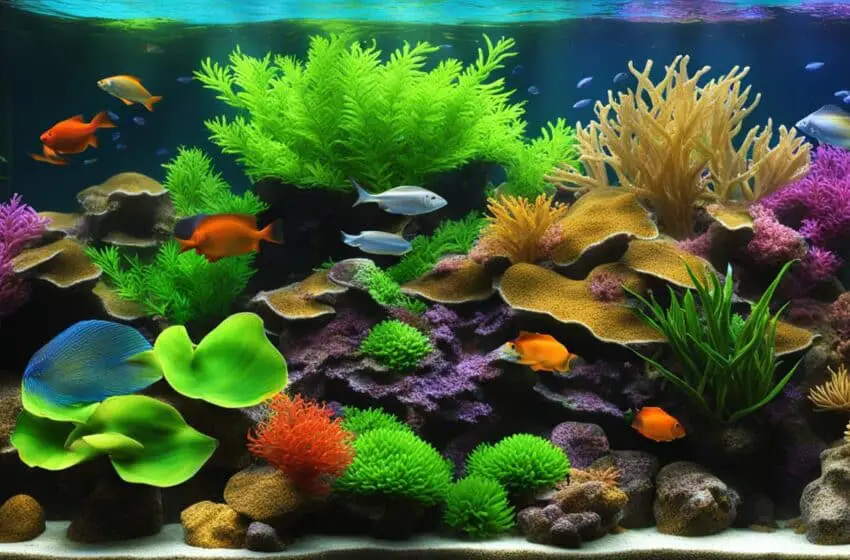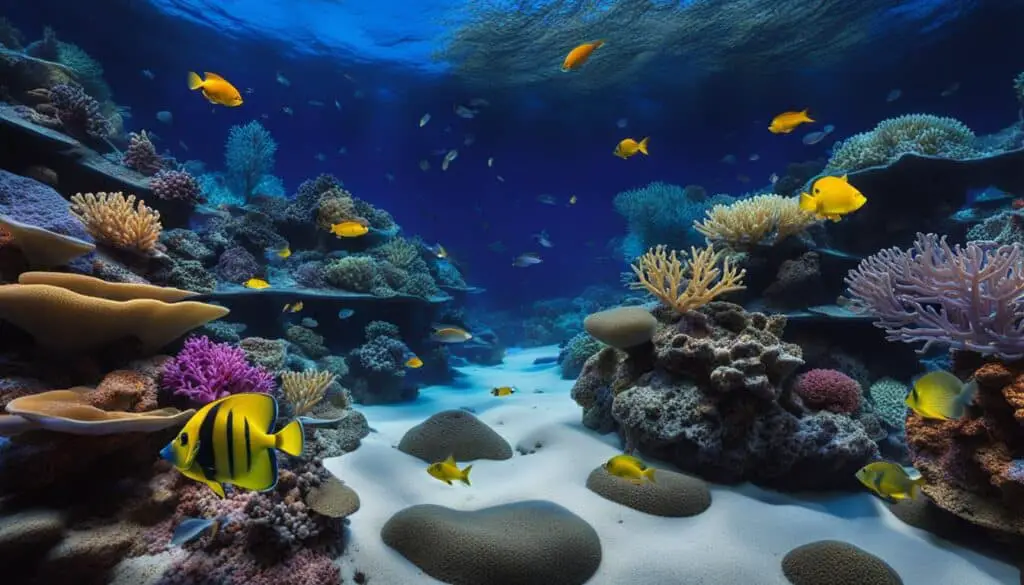Natural Sunlight Simulation in Marine Aquariums

Proper lighting is crucial for the health and growth of marine organisms in a saltwater aquarium. Light plays a significant role in photosynthesis, providing food for corals and other organisms. Corals have specific lighting needs based on their location in the ocean and their adaptation to certain lighting conditions. The spectrum of sunlight incident on coral reefs consists of various wavelengths, with some colors being more important for photosynthesis than others. To replicate the natural lighting conditions in a reef tank, it is important to consider the intensity, wavelength, and timing of the light. Various lighting options, such as HQI bulbs, T5 fluorescent tubes, and LED fixtures, can be used to achieve natural sunlight simulation in a marine aquarium.
Key Takeaways:
- Proper lighting is crucial for the health and growth of marine organisms in a saltwater aquarium.
- Corals have specific lighting needs based on their location in the ocean and their adaptation to certain lighting conditions.
- The spectrum of sunlight incident on coral reefs consists of various wavelengths, with some colors being more important for photosynthesis than others.
- To replicate natural lighting conditions in a reef tank, consider the intensity, wavelength, and timing of the light.
- Various lighting options, such as HQI bulbs, T5 fluorescent tubes, and LED fixtures, can be used to achieve natural sunlight simulation in a marine aquarium.
Importance of Light in Reef Aquariums
Light plays a crucial role in the growth and overall well-being of corals and other organisms in a reef aquarium. It is essential for various biological processes, including nutrient recycling, photosynthesis, and maintaining a healthy ecosystem. Let’s explore why light is so important in reef aquariums and how it affects coral growth, nutrient recycling, and the symbiotic relationship with zooxanthellae.
Coral Growth
Light is one of the key factors influencing coral growth in a reef aquarium. Corals rely on photosynthesis, an essential process carried out by zooxanthellae, to obtain energy and nutrients. Zooxanthellae are photosynthetic algae that live inside the coral’s tissues. They convert light energy into carbohydrates, providing food for the coral. The availability of sufficient light is crucial for the growth and development of corals, ensuring they receive an adequate supply of nutrients for their metabolic needs.
Nutrient Recycling
Light plays a critical role in nutrient recycling within a reef aquarium. Many organisms, such as bacteria, algae, and invertebrates, are involved in the breakdown and recycling of organic matter and waste in the aquarium. These organisms rely on light to carry out their metabolic processes and play a vital role in maintaining water quality and equilibrium. Without proper lighting, nutrient recycling can be compromised, leading to imbalances that can negatively impact the health of corals and other organisms.
Photosynthesis and Zooxanthellae
Photosynthesis is a key process for corals, and it is carried out by zooxanthellae. These photosynthetic algae utilize light to convert carbon dioxide and water into oxygen and carbohydrates, providing energy not only for themselves but also for the coral host. The energy produced through photosynthesis is vital for the coral’s growth, reproduction, and overall health. Therefore, providing the right amount and quality of light is crucial for ensuring optimal photosynthesis and the well-being of both corals and zooxanthellae.
Light Acclimation
Corals, anemones, and giant clams have adapted to specific lighting conditions based on their natural habitats on the coral reef. Sudden changes or high-intensity light can be stressful and even harmful to corals. Therefore, a process called light acclimation is crucial before placing corals in their final spot within the aquarium. Light acclimation involves gradually increasing the intensity and duration of light to allow corals to adjust and avoid any potential damage. This process ensures that corals can thrive under the light conditions provided in the reef aquarium.
Fluctuations and Stability
In their natural environment, corals experience natural fluctuations in light intensity throughout the day due to cloud movements, changes in atmospheric conditions, and the angle of the sun. These fluctuations can benefit corals by reducing oxidative stress and promoting natural light acclimation. Therefore, replicating light fluctuations in a reef aquarium, within a stable range, can be beneficial for the development of protective pigments and the associated vibrant colors seen in corals, anemones, and giant clams.
Understanding Light Spectrum in Aquariums
Light plays a crucial role in the health and well-being of marine organisms in aquariums. As a form of electromagnetic radiation, light can be seen by the human eye in the form of visible colors. The visible spectrum ranges from approximately 400 nm to 700 nm, with each color corresponding to a specific wavelength.
When it comes to aquarium lighting, it’s important to understand the various components of the light spectrum. Natural sunlight, for example, contains not only the visible spectrum but also ultraviolet and infrared radiation. While these additional wavelengths can be harmful to fish, corals, and invertebrates, certain uses of ultraviolet light, such as UV-A light, can be beneficial in reef aquariums to produce fluorescence on corals.
It’s worth noting that as light interacts with water molecules and dissolved substances in the aquarium, such as phytoplankton and organic matter, there is a change in intensity and spectrum due to selective attenuation of different colors. As the depth of the aquarium increases, the available light becomes bluer and less red, replicating the natural lighting conditions found in the ocean.
Below is a simplified illustration of the light spectrum and the corresponding wavelengths:
| Color | Wavelength Range (nm) |
|---|---|
| Violet | 400 – 450 |
| Blue | 450 – 495 |
| Green | 495 – 570 |
| Yellow | 570 – 590 |
| Orange | 590 – 620 |
| Red | 620 – 700 |
The understanding of the light spectrum and its impact on aquarium ecosystems is crucial for recreating natural lighting conditions and providing the necessary wavelengths for the health and growth of marine organisms.
The Role of Photosynthetic Pigments in Coral Growth
Photosynthetic pigments, such as chlorophyll and carotenoids, play a crucial role in the photosynthesis process of zooxanthellae. These pigments absorb certain wavelengths of light, converting light energy into chemical energy for photosynthesis. The absorption response of these pigments is highest in the violet/blue and red range of the spectrum, while colors in the green and yellow range have little importance for the metabolism of zooxanthellae.
In reef aquarium lighting systems, the attenuation of green and yellow colors does not significantly impact the biology of corals, clams, and invertebrates. Intense red light radiation can lead to photosynthetic photoinhibition reactions in zooxanthellae, resulting in their expulsion from the coral host and potential death. Blue light has been found to promote higher photosynthesis rates, zooxanthellae density, chlorophyll content, and overall growth in corals.

| Color | Importance |
|---|---|
| Violet/Blue | Crucial for photosynthesis and growth |
| Red | Crucial for photosynthesis and growth |
| Green/Yellow | Little importance for metabolism |
The Benefits of Moonlight in Reef Tanks
Moonlight plays a crucial role in the intricate ecosystem of reef tanks. Although moonlight is considerably dimmer than sunlight and does not support photosynthesis, it serves several important functions that contribute to the well-being of marine organisms.
Nocturnal creatures rely on moonlight for illumination during their active periods. While diurnal species find comfort in darkness, nocturnal creatures utilize the low-intensity moonlight to forage, hunt, and navigate their surroundings. Regulating the intensity and color of moonlight in reef tanks is essential to avoid disturbing or frightening timid animals.
Furthermore, moonlight serves as an environmental cue, helping marine organisms, including corals, predict tidal activity. Subtle differences in moonlight intensity throughout the lunar cycle provide valuable cues for these creatures, allowing them to synchronize their behaviors and biological rhythms with the natural ebb and flow of the tide.
In reef tanks, mimicking the effects of moonlight can provide several benefits. For nocturnal foragers, moonlight simulation aids in their natural feeding patterns and promotes their overall well-being. By reducing stress for diurnal species, moonlight simulation creates a more natural and harmonious environment within the aquarium.
One remarkable phenomenon associated with moonlight in reef tanks is coral fluorescence. Under moonlight or artificial blue light, corals exhibit a stunning display of vibrant colors as their fluorescent pigments absorb and re-emit light at different wavelengths. This captivating phenomenon adds visual appeal to reef tanks and allows for better observation of nocturnal activity.
To replicate the natural lunar cycle and harness the benefits of moonlight in reef tanks, dedicated moonlight fixtures are available. These fixtures emit low-intensity, usually blue light, precisely simulating the subtle illumination of moonlight. Careful consideration of the lunar cycle and the intensity of moonlight can help maintain a healthy balance in the aquarium and support the stability of biological clocks for the marine organisms within.
Benefits of Moonlight in Reef Tanks:
- Aids nocturnal foraging activities
- Reduces stress for diurnal species
- Regulates biological clocks
- Enhances coral fluorescence
- Allows better observation of nocturnal activity

| Benefits | Description |
|---|---|
| Aids nocturnal foraging activities | Provides illumination for nocturnal creatures to forage, hunt, and navigate their surroundings during their active periods. |
| Reduces stress for diurnal species | Creates a more natural and harmonious environment for diurnal species by simulating the darkness they seek for rest and recovery. |
| Regulates biological clocks | Helps marine organisms synchronize their behaviors and biological rhythms with the natural ebb and flow of the tide. |
| Enhances coral fluorescence | Under moonlight or artificial blue light, corals exhibit a stunning display of vibrant colors as their fluorescent pigments absorb and re-emit light at different wavelengths. |
| Allows better observation of nocturnal activity | Creates an opportunity for aquarium enthusiasts to observe the fascinating nocturnal behaviors of marine organisms in a dim, moonlit environment. |
SKY – An Advanced LED Lighting Solution for Reef Aquariums
The SKY LED light is a high-quality lighting solution specifically designed for reef aquariums. It offers a natural lighting simulation by providing a blend of wavelengths that ensures optimal coral growth, coloration, and overall health.
The SKY features patented diffuser technology, creating a homogeneous field of diffused light without harsh shadows or fractured spectra. This diffused light closely replicates the natural lighting conditions found in coral reefs, providing a visually pleasing and natural-looking illumination for the aquarium.
With its optimized spectrum, the SKY LED light promotes healthy coral growth by delivering the right balance of light intensity and color. Whether it’s the intense blue wavelengths that enhance fluorescence or the gentle blend of warm and cool tones that accentuate the natural colors of corals, the SKY LED light provides the perfect lighting environment for your reef aquarium.
Simple Installation and Setup
Setting up the SKY LED light is quick and easy. You have the option to connect it to an Apex system for seamless integration, or operate it independently wirelessly via a mobile device. Whichever method you choose, you can be sure of a hassle-free installation process.
Coverage and Longevity
The SKY LED light covers a significant area, ensuring proper lighting for coral propagation and growth. Its advanced thermal management system keeps the LEDs cool, prolonging their lifespan and ensuring consistent performance over time.
Moonlight Functionality
The SKY LED light also features moonlights, two discrete blue and white LEDs that can operate in sync with the phases of the moon. This additional functionality not only enhances the aesthetic appeal of your aquarium but also provides environmental cues for the inhabitants, mimicking the natural lunar cycle.
Experience the difference that the SKY LED light can make in your reef aquarium. With its natural lighting simulation, optimized spectrum, and diffused light, it’s the perfect lighting solution to create a vibrant and thriving marine ecosystem.
Conclusion
Achieving optimal lighting conditions in a saltwater aquarium is crucial for the health and growth of corals, invertebrates, and other marine organisms. By simulating natural sunlight using a combination of lighting fixtures like HQI bulbs, T5 fluorescent tubes, or LED lights, you can provide the necessary light intensity, spectrum, and timing for photosynthesis and other essential biological processes.
When setting up your aquarium, it’s important to consider the specific lighting needs of the corals based on their natural habitat and adaptation to certain lighting conditions. Replicating natural lighting conditions, including the intensity and color spectrum, helps create an environment that promotes coral growth and overall ecosystem balance.
Additionally, incorporating moonlight in the aquarium offers benefits such as aiding nocturnal activities, reducing stress for diurnal species, and regulating biological clocks. This can be achieved by using moonlight fixtures that emit low-intensity, usually blue light, mimicking the moon’s natural cycle.
The SKY LED light is an advanced lighting solution specifically designed for reef aquariums. With its optimized spectrum and diffused light, the SKY provides a natural lighting simulation that promotes coral growth, coloration, and overall health. By following expert sunlight simulation techniques and utilizing advanced lighting solutions like the SKY, you can create vibrant and thriving marine ecosystems in your saltwater aquarium.
FAQ
Why is proper lighting important for marine organisms in a saltwater aquarium?
Proper lighting is crucial for the health and growth of marine organisms as it plays a significant role in photosynthesis, providing food for corals and other organisms.
What are the specific lighting needs of corals in a reef aquarium?
Corals have specific lighting needs based on their location in the ocean and their adaptation to certain lighting conditions. Replicating natural lighting conditions in a reef tank requires considering the intensity, wavelength, and timing of the light.
What are the various lighting options for simulating natural sunlight in a marine aquarium?
Various lighting options such as HQI bulbs, T5 fluorescent tubes, and LED fixtures can be used to achieve natural sunlight simulation in a marine aquarium.
How does light impact the biology of corals, clams, and invertebrates?
Light is crucial for the growth and health of these organisms as they rely on light for survival, photosynthesis, and adaptation to specific lighting conditions and water movement.
What is the role of photosynthetic pigments in coral growth?
Photosynthetic pigments such as chlorophyll and carotenoids play a crucial role in the photosynthesis process of zooxanthellae, providing energy for coral growth and overall health.
What is the significance of moonlight in a reef aquarium?
Moonlight has a significant influence on coral reefs and marine organisms, aiding nocturnal activities, reducing stress, regulating biological clocks, enhancing coral fluorescence, and allowing better observation of nocturnal activity.
What is the SKY LED light and how does it contribute to natural lighting simulation in reef aquariums?
The SKY LED light is a high-quality lighting solution designed specifically for reef aquariums. It provides a blend of wavelengths that simulates natural lighting conditions, ensuring optimal coral growth, coloration, and overall health.
How can aquarists achieve optimal lighting conditions in a saltwater aquarium?
By simulating natural sunlight using a combination of lighting fixtures, such as HQI bulbs, T5 fluorescent tubes, or LED lights, aquarists can provide the necessary light intensity, spectrum, and timing for photosynthesis and biological processes in their reef aquarium.



